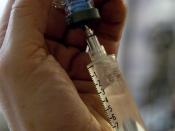Hemophilia is the best known of hemorrhagic disorders. When a person has hemophilia, the blood does not clot properly and bleeding persists. The people who have hemophilia are called hemophiliacs or bleeders. Bleeding disorders, such as hemophilia, result from a disruption of the body's process of how blood clots are formed. The coagulation process involve platelets as well as plasma proteins called clotting factors. Clotting begins when platelets stick to the site of an injury to a blood vessel. The proteins in the plasma that cause blood to clot is absent.
Hemophilia is named from a Greek word meaning " fond of blood". There are two types of hemophilia. Hemophilia A, which is the most common and is also called classic hemophilia. Hemophilia B or Christmas disease, named after the first patient diagnosed and treated with hemophilia B. Hemophilia B lacks AHF (antihemophilic factor). About 85% of hemophiliacs have classic or hemophilia A.
Hemophilia A's blood lacks the clotting factor eight. The rest of the 85% have Christmas, which lacks clotting factor nine. An extremely small number of hemophiliacs lack yet another kind of clotting factor.
Both A and B forms have also been called the royal disease. Hemophilia was inherited by decedents of England's Queen Victoria and introduced into the royal houses of Spain, Germany, and Russia.
Hemophilia A and B are caused by genes that are sex linked and recessive. A defective gene on the X chromosome, one of the two chromosomes, that determine a person's sex. The Y chromosomes which has no genes for clotting is the other chromosome. Males have one X chromosome and one Y chromosome. Girls have two X chromosomes. A boy who inherits the hemophilia defect on his X chromosome will most defiantly will be a hemophiliac. A girl who inherits the...


